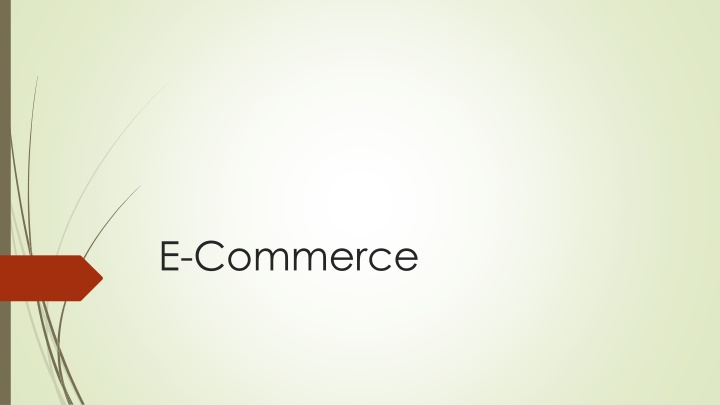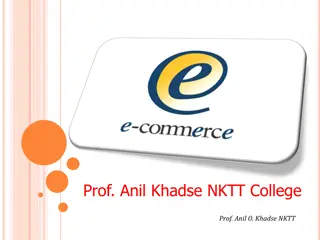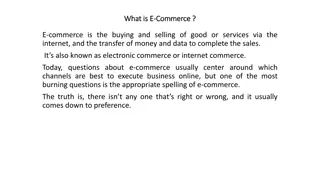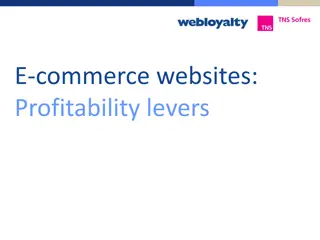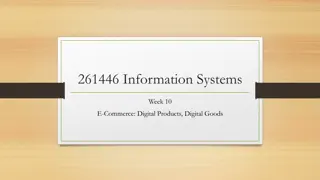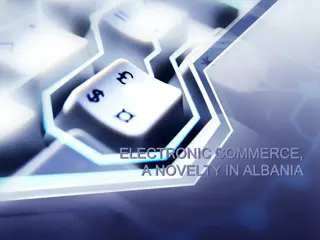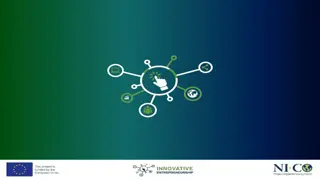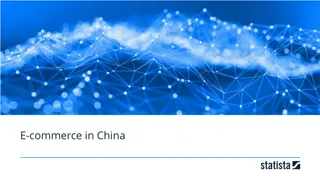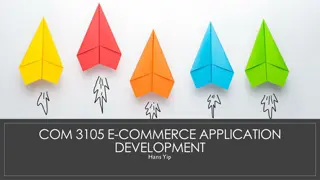E-Commerce
Electronic Commerce, or E-Commerce, involves the buying and selling of products or services online. This content covers the definition of E-Commerce, differences between Traditional Commerce and E-Commerce, features, advantages, disadvantages, and the scope of E-Commerce. Explore the global reach, universal standards, information richness, interactivity, customization, and more. Learn about the benefits of better customer service, lower costs, increased efficiency, and drawbacks like privacy concerns and lack of personal touch.
Download Presentation

Please find below an Image/Link to download the presentation.
The content on the website is provided AS IS for your information and personal use only. It may not be sold, licensed, or shared on other websites without obtaining consent from the author.If you encounter any issues during the download, it is possible that the publisher has removed the file from their server.
You are allowed to download the files provided on this website for personal or commercial use, subject to the condition that they are used lawfully. All files are the property of their respective owners.
The content on the website is provided AS IS for your information and personal use only. It may not be sold, licensed, or shared on other websites without obtaining consent from the author.
E N D
Presentation Transcript
Definition Electronic Commerce means buying and selling of products or services by businesses and consumers over the internet. E-commerce is the business environment in which information for buying, selling and transportation of goods and services moves electronically. E-commerce means selling and buying products and services through web storefronts. E-commerce means using the Internet and the web for business transactions and/or commercial transactions, which typically involve the exchange of value (e.g., money) across organizational or individual boundaries in return for products and services. E-commerce is a modern business methodology. It addresses the needs of organizations, merchants and consumers to cut cost and to improve the quality of goods and services.
Difference between Traditional Commerce Vs. E-commerce: Traditional Commerce Scope is local or regional. Time required for business transaction is in terms of week. Product Attributes are selected by seller. Prices are listed by taking over view of local market. Service is available between 9 a.m to 5 p.m. in weekdays. Marketing focus is related to product position. Asset for traditional business is location of shop. Value proposition is related to product. E-Commerce 1 2 1 2 Scope is Global. Time required for business transaction is in terms of minutes. Product attributes are selected by buyer. 3 3 4 4 Prices are listed by taking over view of global market. 24 hours service is available for all 7 days. 5 5 6 6 Marketing focus is related to customer relation. Asset to E-commerce is customer database. Value proposition is related to product, information and service. 7 7 8 8
Features of E-commerce: Ubiquity: Global Reach: Universal Standards: Information richness: Interactivity: Information Density: Customization: Social technology:
Advantages of E-commerce: Provides better customer service Lower cost and prices Increase in efficiency and accuracy Improved productivity Requires less marketing efforts On-line communication Simple administration
Disadvantages of E-commerce: Change in business environment and technological issues Privacy and security problem Inefficient consumer search Requirement of intermediate No One Can Buy During a Site Crash Lack Of Personal Touch Need For Internet Access Credit Card Fraud Many products can not buy online
Scope of E-commerce: Electronic Market EDI Internet Commerce
Types of E-commerce: Business - to - Business (B2B) Business - to - Consumer (B2C) Consumer - to - Consumer (C2C) Business - to - Government (B2G) Peer to Peer (P2P)
Business Models in E-commerce: Advertising Revenue Model Subscription Revenue Model Transaction Fees Revenue Model Sales Revenue Model Affiliate Revenue Model
B2C Models in E-commerce: Portal Vortal E-tailer Content Provider Transaction Broker Market Creator Service Provider Community Provider
E-commerce Security Integrity Non Repudiation Authenticity Confidentiality Availability
EDI EDI exchange of data or business documents in electronic format between trading partners. This exchange of documents is generally between buyer and supplier and consists of transferring payments, shipping notices and various other documents and by nature eliminates operational efficiency and enhances virtual exchanges with new trading partners. With EDI, any company can virtually interact with another organisation anywhere in the world without the hassle of waiting times and forecasting future procedures. or Electronic Data Interchange is the virtual purchase orders, invoices, paper trails, improves
The process flow EDI replaces the manual processes involved in ordering and distribution, electronic trading between both buyer and supplier. EDI eliminates waiting times associated with manual processing, provides users with real-time product and stock level information, creates benchmarks for future sales forecasting and reduces overheads by creating an efficient business process. creating seamless
EDI Documents Following are the few important documents used in EDI Invoices Purchase orders Shipping Requests Acknowledgement Business Correspondence letters Financial information letters
Steps in an EDI System Following are the steps in an EDI System. A program generates a file that contains the processed document. The document is converted into an agreed standard format. The file containing the document is sent electronically on the network. The trading partner receives the file. An acknowledgement document is generated and sent to the originating organization.
Advantages of an EDI System Following are the advantages of having an EDI system. Reduction in data entry errors. Chances of errors are much less while using a computer for data entry. Shorter processing life cycle Orders can be processed as soon as they are entered into the system. It reduces the processing time of the transfer documents. Electronic form of data It is quite easy to transfer or share the data, as it is present in electronic format. Reduction in paperwork As a lot of paper documents are replaced with electronic documents, there is a huge reduction in paperwork. Cost Effective As time is saved and orders are processed very effectively, EDI proves to be highly cost effective. Standard Means of communication EDI enforces standards on the content of data and its format which leads to clearer communication.
Encryption : Readable data to cipher text Decryption : Cipher text to readable data Private Key Encryption (One Key) Public Key Encryption (Two Key)
Digital Signature A digital signature guarantees the authenticity of an electronic document communication and uses encryption techniques to provide proof of original documentation. Digital signatures are used in e-commerce, software distribution, financial transactions and other situations that rely on forgery or tampering detection techniques. A digital signature is also known as an electronic signature. or message in digital and unmodified
How Does Digital Signature Work? A digital signature is applied and verified, as follows: The public/private key supplier shares the public key with the end user(s). The sender, using his private encrypted signature to the message or document. The end user decrypts the document and verifies the signature, which lets the end user know that the document is from the original sender. document or message sender (signer) or key, appends the
Secure Socket Layer (SSL) Secure supervises server identification and authentication. It also manages client authentication and encrypted communication between servers and clients. SSL is a standard security technology for protecting encrypted communications between a server and the recipient of its stored information. SSL security typically establishes a secure link between a Web server, or an ecommerce website One common example is when SSL is used to secure communication between a web browser and a web server. This turns a website's address from HTTP to HTTPS, the S standing for secure . sockets layer is a computer networking protocol that
Secure Electronic Transaction (SET) It is a secure protocol developed by MasterCard and Visa in collaboration. Theoretically, it is the best security protocol. It has the following components Card Holder's Digital Wallet Software Digital Wallet allows the card holder to make secure purchases online via point and click interface. Merchant Software This software helps merchants to communicate with potential customers and financial institutions in a secure manner. Payment Gateway Server Software Payment gateway provides automatic and standard payment process. It supports the process for merchant's certificate request. Certificate Authority Software This software is used by financial institutions to issue digital certificates to card holders and merchants, and to enable them to register their account agreements for secure electronic commerce.
Payment Systems Credit Card Payment using credit card is one of most common mode of electronic payment. Credit card is small plastic card with a unique number attached with an account. It has also a magnetic strip embedded in it which is used to read credit card via card readers. When a customer purchases a product via credit card, credit card issuer bank pays on behalf of the customer and customer has a certain time period after which he/she can pay the credit card bill. It is usually credit card monthly payment cycle. Debit Card Debit card, like credit card, is a small plastic card with a unique number mapped with the bank account number. It is required to have a bank account before getting a debit card from the bank. The major difference between a debit card and a credit card is that in case of payment through debit card, the amount gets deducted from the card's bank account immediately and there should be sufficient balance in the bank account for the transaction to get completed; whereas in case of a credit card transaction, there is no such compulsion. Debit cards free the customer to carry cash and cheques. Even merchants accept a debit card readily. Having a restriction on the amount that can be withdrawn in a day using a debit card helps the customer to keep a check on his/her spending.
Payment Systems Smart Card Smart card is again similar to a credit card or a debit card in appearance, but it has a small microprocessor chip embedded in it. It has the capacity to store a customer s work-related and/or personal information. Smart cards are also used to store money and the amount gets deducted after every transaction. Smart cards can only be accessed using a PIN that every customer is assigned with. Smart cards are secure, as they store information in encrypted format and are less expensive/provides faster processing. Mondex and Visa Cash cards are examples of smart cards. E-Money E-Money transactions refer to situation where payment is done over the network and the amount gets transferred from one financial body to another financial body without any involvement of a middleman. E-money transactions are faster, convenient, and saves a lot of time. Online payments done via credit cards, debit cards, or smart cards are examples of emoney transactions. Another popular example is e-cash. In case of e-cash, both customer and merchant have to sign up with the bank or company issuing e-cash.
Payment Systems Electronic Fund Transfer (EFT) It is a very popular electronic payment method to transfer money from one bank account to another bank account. Accounts can be in the same bank or different banks. Fund transfer can be done using ATM (Automated Teller Machine) or using a computer. Nowadays, internet-based EFT is getting popular. In this case, a customer uses the website provided by the bank, logs in to the bank's website and registers another bank account. He/she then places a request to transfer certain amount to that account. Customer's bank transfers the amount to other account if it is in the same bank, otherwise the transfer request is forwarded to an ACH (Automated Clearing House) to transfer the amount to other account and the amount is deducted from the customer's account. Once the amount is transferred to other account, the customer is notified of the fund transfer by the bank.
Payment Systems E-Wallet E-Wallet is a prepaid account that allows the customer to store multiple credit cards, debit card and bank account numbers in a secure environment. This eliminates the need to key in account information every time while making payments. Once the customer has registered and created E-Wallet profile, he/she can make payments faster. Netbanking This is another popular way of making e-commerce payments. It is a simple way of paying for online purchases directly from the customer s bank. It uses a similar method to the debit card of paying money that is already there in the customer s bank. Net banking does not require the user to have a card for payment purposes but the user needs to register with his/her bank for the net banking facility. While completing the purchase the customer just needs to put in their net banking id and pin.
Payment Systems Mobile Payment One of the latest ways of making online payments are through mobile phones. Instead of using a credit card or cash, all the customer has to do is send a payment request to his/her service provider via text message; the customer s mobile account or credit card is charged for the purchase. To set up the mobile payment system, the customer just has to download a software from his/her service provider s website and then link the credit card or mobile billing information to the software.
